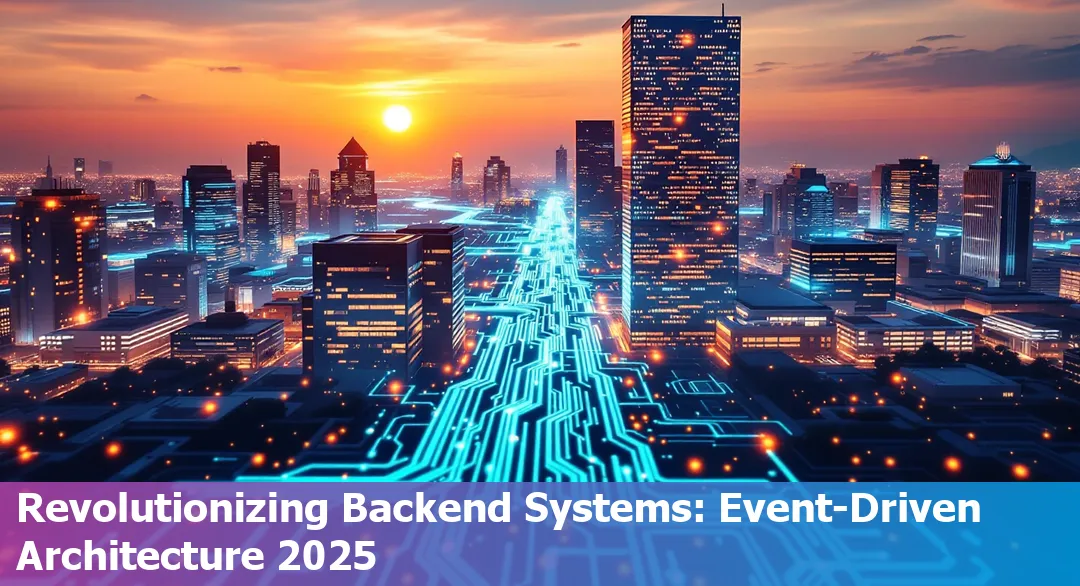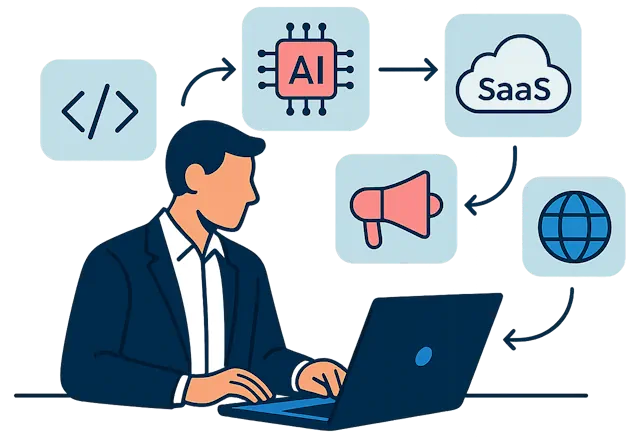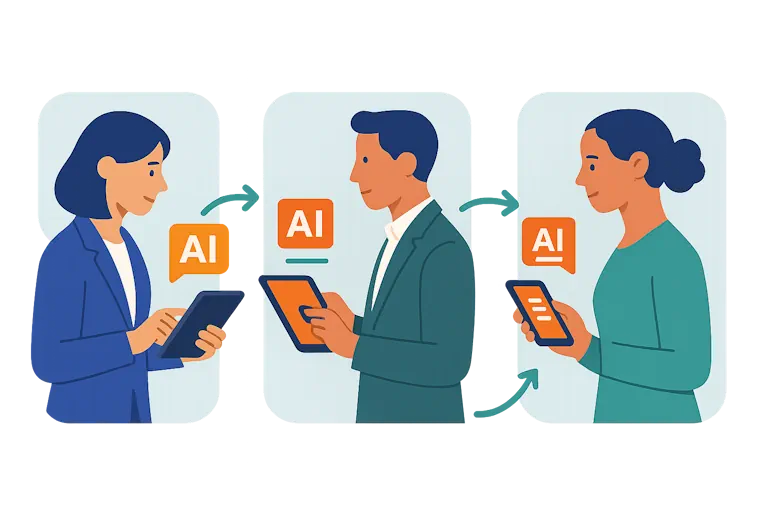Event-Driven Architectures: How Backend Systems Are Changing in 2025
Last Updated: February 20th 2025

Too Long; Didn't Read:
Event-driven architectures (EDA) in 2025 are revolutionizing backend systems with real-time processing, adopted by 85% of organizations. Key components include event producers, brokers, and consumers, allowing over 1.8 billion daily requests at Netflix. Tools like Apache Kafka and AWS Lambda enable scalable, eco-friendly, and AI-driven systems, essential for modern applications. Despite complexities like event ordering, EDA supports efficient, responsive operations, crucial for competitive digital innovations and handling billions of global internet users.
Event-driven architectures (EDA) in 2025 are transforming backend systems into something way more dynamic, allowing them to respond instantly to any changes or updates.
According to recent industry data, 85% of organizations now recognize EDA's business value, with real-time processing being a game-changer.
The architecture works through three main parts: event producers that create the signals, brokers that direct traffic, and consumers that take action. What's super cool is how these systems can scale horizontally, handling massive amounts of concurrent users without breaking a sweat.
Major companies are already showing what's possible - like Netflix processing over 1.8 billion requests daily. Looking at 2025, we're seeing EDAs level up with AI-powered event management and eco-friendly coding practices.
The most exciting part? Real-world applications are getting wild - from predictive maintenance systems to smart city infrastructure.
Tools like Apache Kafka and AWS Lambda are making it easier than ever to build these systems. With over 5 billion internet users globally, EDAs aren't just nice to have anymore - they're absolutely essential for creating systems that can handle whatever the future throws at them.
Table of Contents
- Key Components of EDA
- Tools and Technologies Facilitating EDA
- Advantages and Challenges of Embracing EDA
- Future Trends and Applications of EDA
- Conclusion
- Frequently Asked Questions
Find out the demand for skills in cloud computing and AI/ML as you plan your backend development career.
Key Components of EDA
(Up)Event-Driven Architecture (EDA) is revolutionizing backend systems through three essential components that make everything work like a well-oiled machine. There's the event producer, event broker, and event consumer.
Think of it like a social media platform - when you post something (producer), the platform (broker) makes sure your followers (consumers) get the update.
The real magic happens with the event broker - it's literally the backbone of the whole system.
Popular tools like Apache Kafka and Amazon SNS/SQS handle these massive event streams, processing trillions of messages daily without breaking a sweat.
What's super cool is how these components can work independently - if one part gets overwhelmed, it doesn't crash the entire system.
The consumer side is where things get interesting.
Event consumers subscribe to specific events and process them based on their needs, kind of like how you might only want notifications for certain accounts you follow.
This setup is perfect for handling real-world scenarios like processing payments, updating inventory, or sending notifications. The best part? Each component can scale up or down as needed, making it super efficient and cost-effective.
For example, during a flash sale, the system can automatically handle the surge in orders without slowing down the whole platform.
Tools and Technologies Facilitating EDA
(Up)Event-driven architectures (EDA) in 2025 are powered by game-changing tools that make real-time data processing totally achievable. Apache Kafka has become the go-to solution for building flexible and responsive systems, handling massive amounts of data streams without breaking a sweat.
Over 150,000 organizations now use Kafka, making it pretty much the standard for data streaming. AWS serverless services are crushing it too, letting developers create fault-tolerant applications that scale automatically and keep costs in check.
The latest stats show AWS Lambda users cutting their infrastructure costs by up to 30%, which is seriously impressive. Real-time AI and machine learning integration is taking things to the next level, enabling instant decision-making for stuff like fraud detection and personalized recommendations.
Companies using these tools are seeing major improvements in how they handle data - Netflix uses Kafka for streaming, while DoorDash relies on event-driven systems for real-time delivery updates.
What makes this tech stack particularly awesome is how it lets developers focus on building cool features instead of worrying about infrastructure. The combination of these tools isn't just making systems faster and more reliable; it's changing how we think about building modern applications.
With features like automatic scaling, fault tolerance, and real-time processing becoming standard, these technologies are basically essential for any serious backend development in 2025.
Advantages and Challenges of Embracing EDA
(Up)Event-driven architectures (EDA) have totally transformed how we build backend systems in 2025. Real-time responsiveness is a major win, letting systems react instantly to changes and user actions.
The architecture's loose coupling means different parts of the system can work independently, making it easier for dev teams to build and update features without breaking things.
When it comes to handling heavy loads, EDA is seriously impressive - scalability becomes way smoother since components can scale up or down based on what's needed at the moment.
But let's be real - it's not all perfect.
Managing event flows and keeping everything consistent can get pretty complex.
When you're dealing with events happening all over the place, making sure they stay in the right order is like trying to organize a massive group chat - things can get messy fast.
Plus, debugging these systems requires a different mindset since you're tracking events across multiple services instead of just following a straight line of code.
The eventual consistency thing can also be tricky - sometimes data takes a minute to sync up across all services, which can confuse users if they're not expecting it.
Future Trends and Applications of EDA
(Up)Event-driven architectures (EDA) have transformed how major tech companies handle massive data operations in 2025. Netflix and Uber now process billions of events daily, showing just how crucial EDA has become for large-scale systems.
Netflix's platform delivers personalized content recommendations through real-time event processing, while DoorDash's recent in-house search engine upgrade achieved a two-fold latency reduction and cut hardware costs by 75%.
The latest security implementations in EDA are seriously impressive.
Companies now use event-driven security monitoring to catch and stop cyber threats faster than ever. Companies are implementing advanced event processing styles, from simple stock updates to complex decision-making systems for things like surge pricing.
Green computing is getting more attention too - smart event processing and efficient resource allocation are helping companies use less energy while handling more data.
AI is taking EDA to the next level, making systems smarter at predicting issues before they happen.
Machine learning algorithms now analyze event patterns to automatically scale resources and prevent system overloads. This intelligence helps businesses respond instantly to changes in user demand and system performance.
The best part is how these systems keep getting better at understanding and adapting to real-world situations, making applications faster and more reliable for users.
With platforms handling millions of events per second, EDA is essential for modern tech infrastructure.
Conclusion
(Up)Event-Driven Architectures (EDAs) are totally changing the game for backend systems in 2025, and honestly, it's super exciting to see how they're making everything faster and smarter.
Recent studies show that 85% of organizations now recognize the business value of EDA, which is pretty mind-blowing when you think about it.
The real magic happens in how EDAs handle real-time data - over 72% of global organizations are already using it for everything from banking to AI applications.
What's really cool is how companies are seeing massive improvements in responsiveness and cost efficiency after making the switch.
The best part about EDA is how it lets systems instantly react to changes - imagine sending a message and having all the right things happen automatically, without any delays.
It's basically like having a super-smart assistant that knows exactly what to do when something happens. While getting started with EDA can be tricky (trust me, the whole event ordering thing can be a headache), the payoff is totally worth it.
The numbers don't lie - companies are seeing major improvements in their system performance, and the tech just keeps getting better.
Looking ahead, EDA isn't just another tech trend that'll fade away - it's becoming essential for any company that wants to stay competitive in the digital world.
Whether it's handling millions of user interactions or processing data from IoT devices, EDA is making it possible to build systems that are not just fast but also super reliable.
For anyone getting into backend development right now, understanding EDA isn't just a nice-to-have skill anymore - it's becoming as important as knowing your basic programming languages.
Frequently Asked Questions
(Up)What is Event-Driven Architecture (EDA) and how is it changing backend systems in 2025?
Event-Driven Architecture (EDA) in 2025 is transforming backend systems into more dynamic environments, enabling systems to react instantly to changes or updates. This architecture consists of three main components: event producers, event brokers, and event consumers, each working independently to handle vast amounts of concurrent users efficiently.
What are the advantages of implementing EDA in modern backend systems?
The advantages of EDA include real-time processing capabilities, loose coupling for independent system components, and the ability to scale up or down based on demand. It allows systems to react instantly to changes and user actions, improving the performance and efficiency of modern applications.
What challenges are associated with Event-Driven Architectures?
One major challenge with EDA is managing the complexity of ensuring event order across multiple services, which can be difficult to organize and debug. Additionally, handling eventual consistency can confuse users when data takes time to sync across services.
What tools and technologies facilitate the implementation of EDA in 2025?
Tools like Apache Kafka and AWS Lambda are essential for facilitating EDA in 2025. These technologies enable real-time data processing, fault-tolerant applications, and automatic scaling, making it easier for developers to focus on building features rather than infrastructure.
How is AI influencing Event-Driven Architectures?
AI is advancing EDA by enabling smarter systems that can predict issues before they occur. Machine learning algorithms analyze event patterns to automatically scale resources and prevent system overloads, allowing businesses to instantly react to changes in user demand and system performance.
Ensure your APIs are well-documented with comprehensive documentation that facilitates seamless user experience and security.
Explore how Cloud-based solutions in data engineering are setting new industry standards.
AI and ML are taking the front seat in observability, driving significant advancements like AI/ML's role in telemetry analysis that redefine efficiency and accuracy.
Gain valuable tips on selecting an orchestration tool that aligns with your company's specific needs.
Dive into Python's superior real-time processing capabilities as it competes with other leading technologies.
Explore strategies for building resilient multi-cloud pipelines that can withstand the challenges of an ever-evolving tech landscape.
Delve into specific Modern ORM use-cases that highlight their strengths and weaknesses in diverse applications.
Engaging teaser sentence nine, where the edge computing's rise is hyperlinked.
Ludo Fourrage
Founder and CEO
Ludovic (Ludo) Fourrage is an education industry veteran, named in 2017 as a Learning Technology Leader by Training Magazine. Before founding Nucamp, Ludo spent 18 years at Microsoft where he led innovation in the learning space. As the Senior Director of Digital Learning at this same company, Ludo led the development of the first of its kind 'YouTube for the Enterprise'. More recently, he delivered one of the most successful Corporate MOOC programs in partnership with top business schools and consulting organizations, i.e. INSEAD, Wharton, London Business School, and Accenture, to name a few. With the belief that the right education for everyone is an achievable goal, Ludo leads the nucamp team in the quest to make quality education accessible


